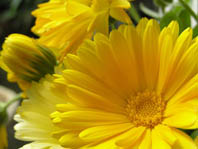Edible Flowers
The bud may have a bitter taste,
But sweet will be the flowír.
— William Cowper
If the idea of eating flowers strikes you as fanciful or faintly ridiculous, how do you feel about broccoli? Or asparagus? These common vegetables are, in fact, immature flowers. And when you leave your broccoli in the garden too long and it develops yellow flowers, it is indeed still edible.
The flowers of most herbs are edible, usually imparting a similar, but milder flavour than the herb itself. Steady favourites include sage (especially pineapple sage)  hyssop, basil, borage, chamomile, dill, fennel, chives, oregano, lavender, marjoram, mustard, clover, linden, rosemary, scented geraniums, thyme, sweet woodruff and winter savory. One of the most enduringly popular edible flowers, calendula, or pot marigold, is in fact an herb. hyssop, basil, borage, chamomile, dill, fennel, chives, oregano, lavender, marjoram, mustard, clover, linden, rosemary, scented geraniums, thyme, sweet woodruff and winter savory. One of the most enduringly popular edible flowers, calendula, or pot marigold, is in fact an herb.
Probably the top six edible flowers, the ones that appear most often as garnishes in high-end restaurants are: nasturtiums, roses, calendula, violets, Johnny-jump-ups (known by herbalists as heartsease or viola tricolor) and squash blossoms (usually from the zucchini). However, there are countless others, too many to list here. Some of your favourite flowers you might be surprised to learn are edible, including: tulips, lilacs, daylilies (popular in Chinese hot & sour soup), the English or wild daisy, carnations and chrysanthemums. The flowers of many fruits and vegetables add colour and nutrition to many a meal. Apple blossoms and the flower of the runner bean are prime examples.
Albeit, and this cannot be emphasised strongly enough, many flowers are poisonous or toxic and unless it has been reliably documented as edible by its botanical name, do not eat it! Also, do not eat flowers from a floristís shop or garden centre. Only eat flowers grown in a totally organic garden. Plants will absorb herbicides, pesticides and chemical fertilizers from the soil.
Other edible flower caveats: If you suffer from hay fever, asthma or allergies, be wary of eating edible flowers. They could trigger a reaction. If wild-crafting edible flowers, be absolutely certain that you have correctly identified the species. And donít pick flowers from the side of the road. They will be contaminated by car exhaust. Remove the pistils, stamens and sepals from the flower and the bitter white area at the base of the petal. Check carefully for any insect hitchhikers. Wash the flowers carefully in cool water and drain them on clean cotton or paper towels.
Itís probably best to grow your own edible flowers. Sourcing them at retail can be a challenge, although some of the natural and organic stores now carry them on a seasonal basis. The most common use of edible flowers, just like parsley, is as a garnish. This is a waste. Edible flowers offer a wealth of taste including sweet, spicy, floral, minty and citrus. Salads are the usual beneficiary of edible flowers, but they can be creatively used in cooking also. Try adding borage or calendula flowers to cooked rice or violets to an omelette. Deep-fired sage blossoms are a popular side dish.
Here are a three very simple recipes using common edible flowers:
Blend chopped nasturtium petals with cream cheese or butter and spread on very thin slices of dark pumpernickel bread for savory appetizers or snacks.
Honeysuckle Strawberry Sorbet: Use only the Lonicera japonica species of honeysuckle. Cut the pistils and stamens from half a cup of honeysuckle flowers. Blend these with three cups of strawberries, hulled and halved, in a blender or food processor. Process until smooth and then pour the mixture into an ice cream maker and freeze.
Johnny Fruit Salad: Peel, section and cut two oranges into bite-sized pieces; add one medium bunch of green, seedless grapes; two cups of strawberries, hulled and halved; one apple, peeled, cored and cut into bite-sized pieces, two kiwi fruits, peeled and thinly sliced. Mix the fruit in a non-reactive bowl (preferably glass) and refrigerate for two hours. Serve in four individual bowls, garnished with five Johnny-jump-up flowers in each bowl.
Similar to herbs, many edible flowers have medicinal qualities. Nasturtiums, native to South America, were a time-honoured Andean remedy for wounds and chest infections, being a powerful antibiotic. Honeysuckle flowers are antispasmodic and were traditionally used to relieve coughs. Honeysuckle is also one of the Bach Flower Remedies and is believed to counter feelings of nostalgia and homesickness. Johnny-jump-ups are a purifying herb and are used for skin conditions such as eczema.
Edible flowers offer an abundance of taste and visual delight in the kitchen, but caution should be king. In some jurisdictions, all flower garnishes must be edible by law, but donít assume this everywhere. If in doubt, donít eat it and brush up on your botany!
Bruce Burnett is a chartered herbalist who has also won four Pacific Asia Travel Association (PATA) Gold awards for travel journalism. Read more of Bruce Burnett's writing on his websites:
1. http://www.globalramble.com
2. http://www.bruceburnett.ca
3. http://www.herbalcuisine.com
|